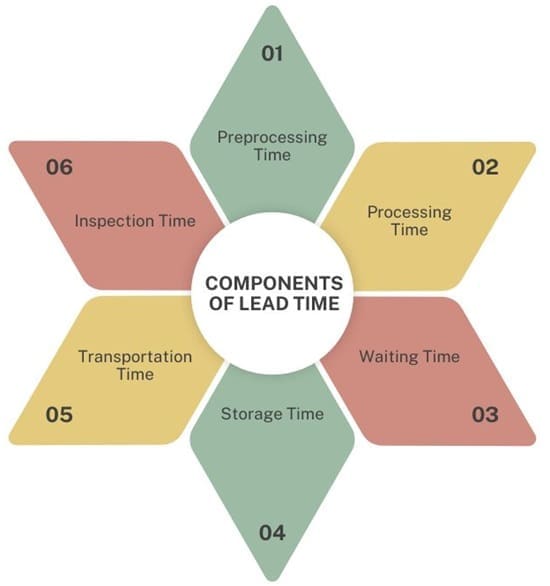Lead time is the total duration from starting a process to its conclusion. When applied to supply chain management, it refers to how long it takes from when an order is placed to when it reaches its final destination. This process includes all stages such as processing an order, manufacturing its components and shipping them out for final distribution.
Table of contents
Definition of Lead Time
Lead time refers to the length of time necessary to complete any process or project. It is usually defined in terms of supply chain operations as from when an order is placed by any entity (such as a vendor, producer, warehouse distributor supplier, or retailer) until their product arrives at their customer
Industry Application
It is used across industries, from manufacturing and supplier management to project and supply chain management, as an indicator of efficiency and productivity.
How to Calculate?
The general formula for calculating it is presented below:
Lead Time = Pre-Processing Time + Processing Time + Post-Processing Time
Its components vary for different kinds of businesses:
- Manufacturing Company: Lead Time = Procurement Time for Raw Materials + Manufacturing Time + Shipping Time
- Retail Company: Lead Time = Procurement Time (final products) + Shipping Time
Importance of Short Lead Time
There are several advantages of shorter lead times:
- Customer Satisfaction: Faster delivery times lead to happier customers. Reduced Obsolescence: Shorter lead times reduce the risk of products becoming outdated more rapidly.
- Lower Labor Costs: Efficient processes help eliminate unnecessary hours spent labouring for production processes.
- Increased Orders: Businesses with faster lead times may attract more customers. Efficient Capital Deployment: Quicker turnaround times free up capital for other uses.
How to Reduce Lead Time?
Companies can take several steps to decrease lead times:

- Reduce Unnecessary Processes: Reduce inefficiencies by cutting unnecessary steps from operations.
- Monitor Shipping Methods: Assess and select the most cost-effective shipping options.
- Incentivize Improved Service: Recognize suppliers and employees for meeting lead time targets with rewards or recognition programs.
- Procure differently: Choose suppliers who can deliver fast service and are located nearby.
- Carry Higher Inventory: To prevent production delays from occurring.
- Reorder Frequently: Place frequent orders so materials will always be on hand at the time of need.
- Promote Internal Learning: Cross-train employees to boost efficiency.
Types
There are four basic forms.
- Customer Lead Time: Time from customer order to delivery.
- Material Lead Time: Time from ordering raw materials to receiving them.
- Production Lead Time: Time to manufacture a product once materials are available.
- Cumulative Lead Time: The total time covering all the above stages.
Why Is it Important For Businesses?
Whilst lead time may not seem important at first, its significance extends far beyond just delivery deadlines and impacts more aspects than anticipated – including employee availability.
- Customer Satisfaction: Meeting customer expectations for timely delivery.
- Inventory Management: Efficiently forecasting and managing stock levels.
- Operational Efficiency: Streamlining processes to reduce waste and improve productivity.
Factors Affecting Lead Time
The factors affecting it are:
- Inventory Management System: Just-in-Time (JIT) systems can reduce these times by matching production to demand.
- Production Processes: Implementing efficient processes can prevent delays and meet schedules more smoothly.
- Supplier: Reliable suppliers with effective Supplier Quality Management (SQM) practices are essential in meeting demand.
Components
It has six different components. These are:

- Preprocessing Time: Time to receive and create a purchase order.
- Processing Time: Time to produce or procure the order.
- Waiting Time: Time waiting for necessary items or raw materials.
- Storage Time: Time items spend in the warehouse before delivery.
- Transportation Time: Time taken to deliver the item to the customer.
- Inspection Time: Time to inspect the products for quality before delivery.
Final Words
An understanding and management of such time is integral for improving efficiency, lowering costs and increasing customer satisfaction across various industries. By cutting back lead times companies can streamline operations while creating an edge over competition in their marketplaces.


















